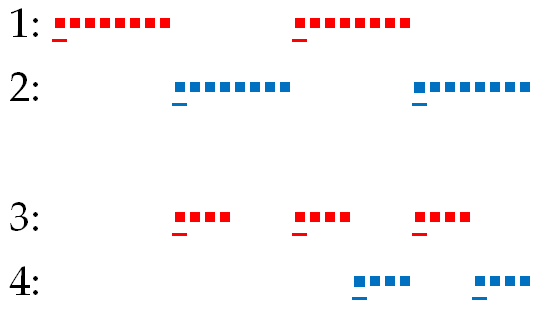samples playing at double speed are going to take half the time to play back as they took to record. (Sorry if that sounds obvious but stating it helps to clarify the situation I hope)
So, how much gap-free backing can your double-speed samples give you, time-wise?
Well, if you halve the time elapsed between start of recording and start of playback that tells you how long the sample playback will last (before it has to stop or loop).
If you record 2 bars and then start playback while you’re playing the third bar, the double speed sample is going to last 1 bar. So if you want fresh material playing back when you start the fourth bar, you need to have sampled your third bar. That sampled third bar is only going to last half of the fourth bar. By the second half of the fourth bar you are going to need some fresh material. Yes, you may have sampled the first half of the fourth bar, and that can last you while you’re playing the third quarter of the fourth bar (I’d call this the third beat, but let’s keep the terms unambiguous). Anyway, you can see that you are going to run out of usable material very quickly.
One ‘solution’ is to play unaccompanied for longer at the start. If you play for 16 bars without backing, you’ll have enough material to back your next 8 bars, during which you can sample enough to last you another 4. And so on.
So that ‘playing for ages before the samples start’ is probably too much of a compromise, especially as you’d still run out of material pretty quickly. You could play unaccompanied for even longer but the OT buffer will max out even with dynamic recording switched on and reserve recorder lengths off.
The next approach that comes to mind is one I think you have already dismissed. That would be chopping, stretching or otherwise manipulating the samples to make them last longer. This would be programmed in advance but, yes, unless you program very carefully based on what you are going to play, the backing will sound like classic break beat manipulation.
If you combine those last two approaches however, you might reach an acceptable trade-off. You could start the piece unaccompanied for a little longer than you originally planned. The samples generated during that period will last you for a couple/few bars, after which you carry on in the typical live sampling style shown in your diagram, except you PLUG THE GAPS by drawing upon the already-sampled material from the beginning (which you set up NOT to be overwritten) Because there’s a good amount of it you can play it back in chunks long enough to function more like phrases than chopped up breaks.
I’d also consider this approach - sampling TWO recordings of you whatever play. Two recordings that DIFFER (in timbre, relative levels of instruments etc.) enough to be used back-to-back, thereby filling the gaps without sounding like a straight loop. Perhaps radically different mic arrangements for the two simultaneous recordings?
Wish I had the time to get stuck into something like this!
Good luck!


 It would be easier for me with A B C answers.
It would be easier for me with A B C answers.